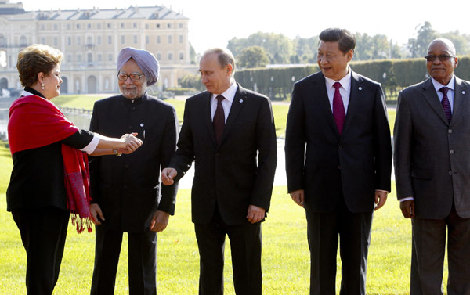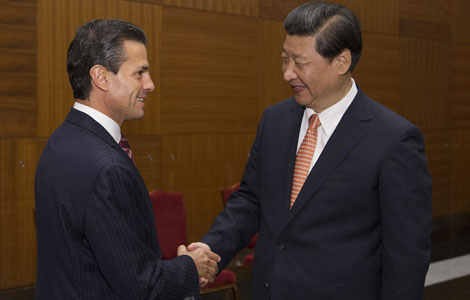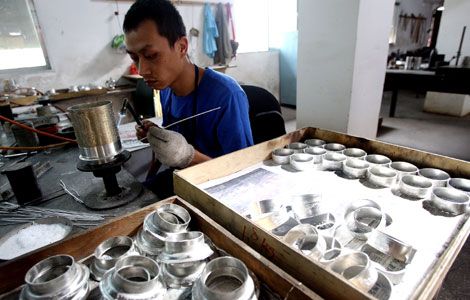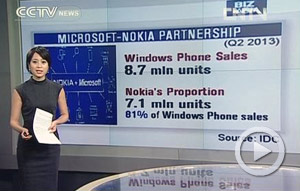Ad giants' merger presents challenges
Updated: 2013-09-05 07:24
(China Daily)
|
||||||||
Management | Du Xiaoying
How can an industry that barely existed in China 30 years ago meet the challenges stemming from the proposed merger of the industry's second- and third-largest players in the world?
A shockwave spread across the Chinese advertising industry after the announcement in late July of the merger between Omnicom Group Inc and Publicis Groupe SA, two major global advertising and marketing services groups.
Many local ad companies see the merger as a potential threat to their already shaky business at a time of economic slowdown and lackluster consumer spending.
But there are also brave companies, which decided to be more aggressive and meet the challenge by taking an expansionist approach. Industry rumor has it that some large Chinese ad firms are planning major overseas takeovers.
Zhang Jinjie, a researcher at the Chinese Academy of Social Sciences' Institute of World Economy and Politics, said he expected the merger to trigger more acquisitions of Chinese ad firms by international players.
"China is already the third-largest M&A market for the world's ad industry," Zhang said.
The country is seeing increasing investment by WPP Plc - the world's largest advertising and marketing services group - and by Omnicom and Publicis, he said.
After the planned merger, competition in the Chinese ad market will probably be fiercer, according to Yin Tiegang, deputy general manager of Beijing Future Advertising Co Ltd. The creation of Publicis Omnicom Group would combine the two companies' funds, clients, staff and experience, resulting in better services and cash flow, and a pricing advantage.
That is seen by Yin as "a threat" for the development of local companies and advertisers.
The main concern for local small ad companies is how to survive in the shadow of their large rivals, especially that of the global advertising giants.
It would be a nightmare for local companies if large global ad companies started making local acquisitions, from coastal large cities all the way down to second- and third-tier cities, said Liu Libin, editor-in-chief of the Chinese-language International Advertising magazine.
"Local companies should remain alert, otherwise they could find themselves in a very difficult position," Liu said.
The Publicis-Omnicom merger would be the largest in the history of the advertising industry. With a combined market value of $35.1 billion, it would control 41 percent of the global advertising market. The new company would overtake WPP, which is worth $24.1 billion and has 32 percent of the global market, to become the world's largest ad and marketing company.
According to media reports, Maurice Levy, chief executive officer of Publicis, pointed out that a key reason for the planned merger was to create a marketing and advertising group strong enough to compete with digital giants such as Google Inc and Facebook Inc.
Advantages such as the effective, precise and detailed data collection of consumer behavior are leading advertisers to invest increasing resources in digital advertising.
According to media reports, in pursuing its digital strategy, Publicis has acquired digital advertising firms such as Razorfish and DigitasLBi. Omnicom, on the other hand, invested in digital advertising companies such as Annalect, a digital ad buying and analytic specialist.
The combined company is expected to have digital abilities strong enough to challenge all of its competitors around the globe.
The reaction of Chinese small ad companies will be to specialize, according to Zhu Xiaogang, general manager of brand communication for DongDao Brand Design and Management.
"We're under great pressure to become more specialized because the global giants are much more advanced in their overall reach. But changes are fast. We are more concentrated. And our cost of talent could be lower," Zhu said.
For China's larger ad companies, especially the privileged few with good cash flow, the strategy can also be to seek their own tie-ups, both at home and abroad.
Beijing-based BlueFocus Communication Group, which was listed on the mainland's growth enterprise market in 2010, is seen as one of the companies best equipped, due to both its capital and size of operations, for such an expansionist strategy. BlueFocus did not exist before 1996, but it now runs 23 regional offices in China, with a total staff of 500. The company has been active in the M&A market and has made a series of deals in the last couple of years.
The ongoing shake-up in the global advertising and marketing industry may offer such an aggressive young company a chance to build itself into a global player.
(China Daily 09/05/2013 page17)

 China, Russia a step closer on gas supply
China, Russia a step closer on gas supply
 18-year-old panda conceives triplets
18-year-old panda conceives triplets
 Testing times for G20 leaders
Testing times for G20 leaders Homemade choppers make aerobatic stunt debut
Homemade choppers make aerobatic stunt debut
 Shanghai's visa-free policy lifts tourism
Shanghai's visa-free policy lifts tourism
 Panda twin cub born at Atlanta Zoo
Panda twin cub born at Atlanta Zoo
 Xi, Mexican president meet for third time
Xi, Mexican president meet for third time
 Samsung unveils smartwatch ahead of rival Apple
Samsung unveils smartwatch ahead of rival Apple
Most Viewed
Editor's Picks

|

|

|

|

|

|
Today's Top News
Brazil asks for apology from US on spying
Xi calls for closer G20 ties
China, Russia a step closer on gas supply
Commuter aviation expected to take flight soon
Japan to test wall for leaking water
18-year-old panda conceives triplets
Films aim for success abroad
Low-budget education abroad for working-class
US Weekly

|

|





